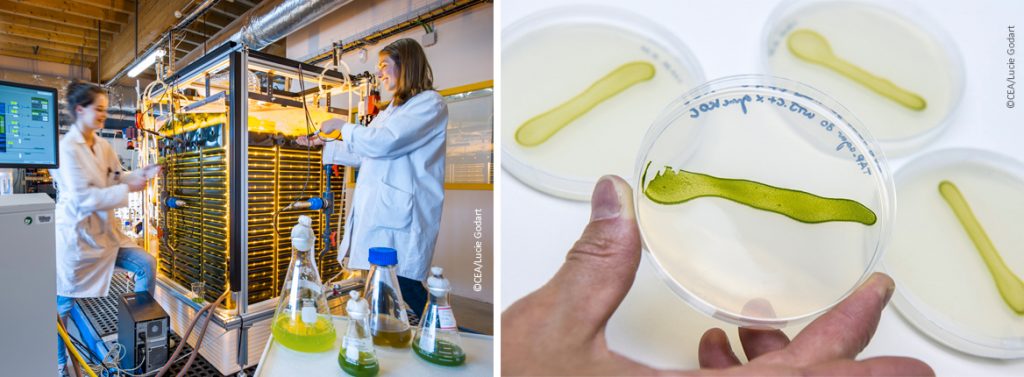
The aim of this first I-BE-C 2021 conference is to discuss the advances From photosynthesis to biotechnologies. It will cover several fields of fundamental and applied research ranging from light harvesting, CO2 acquisition and assimilation, biomass and hydrogen production, or lipid metabolism in plants or microalgae (Chlamydomonas, Nannochloropsis…). Recent progress in enzymatic and microbial fuel cells will also be described.
All this topics will be presented and discussed by leading scientists from all over the world.
Session 1: Light capture and electron transport
Photosynthesis lies at the very base of earth’s terrestrial and oceanic biome. It is the only hybrid technology coupling photo-voltaics and microelectronics to carbohydrate biochemistry. Light absorption, light conversion and electron transfer form a tightly linked and complex process that we will explore in this first session.
Session 2: CO2 acquisition
To fuel the relatively inefficient CO2 fixation reaction catalysed by Rubisco, the primary enzyme of photosynthesis and the most abundant on earth, photosynthetic organisms develop unique structures and dynamic mechanisms to make better use of the trace concentrations of inorganic carbon available in nature. This session will present some key aspects of CO2 acquisition and metabolism by plants, focusing on their response in an ever-changing environment.
Session 3: Solar Biohydrogen
Hydrogen is seen as the solution as a clean and renewable energy vector for the future. Microalgae and cyanobacteria are promising organisms for the production of hydrogen from sunlight, hydrogen being produced by a coupling between the photosynthetic electron transport chain and hydrogenase enzymes. However, hydrogenases and hydrogen production are dramatically impaired by oxygen p roduced by photosynthesis, thus limiting industrial developments. This session will present recent advances in the field of hydrogen photoproduction, from studies on hydrogenase enzymes, to optimized protocols to reach high rates of hydrogen photoproduction.
Keywords: Hydrogen, Hydrogenase, Cyanobacteria, Microalgae, Photosynthesis
Session 4: Lipid metabolism and lipid biofuel
Fatty acids and lipids are synthesized by all cells. They are basic building blocks of biological membranes, part of cellular signaling network, and major form of carbon and energy storage. Lipids from photosynthetic organisms have been studied not only for their roles in physiology and development, but also for their utility in industrial applications ranging from food, feed to fuel. This session will present current advances in the study of algal lipid metabolism and lipid-based biofuels. It will also provide an opportunity to stimulate discussions, networking and initiate collaborations between laboratories in the field.
Keywords: Triacyglycerols, Fatty acids, Hydrocarbons, Lipid droplets, Algae
Session 5: Production and applications of algal biomass
This topic will focus on current and future innovative solutions to improve algae production methods, both from an efficiency and a from a sustainability perspective, with introductory talks from prominent speakers bringing forward their experience in the field. It will incorporate an in-depth look into the most recently developed technologies and processes, as well as strategies to bring algae to the next level, on a standards, awareness and market standpoint.
Session 6: Core technologies and industrial microalgae
Industrial microalgae can transform the way our society produce food, feed, fuel and medicine. This session will present advances in synthetic biology of industrial microalgae (Nannochloropsis, Chlorella, etc), and introduce emerging technology platforms that may usher in a new era of microalgal feedstock development.
Keywords: Genome engineering, Phenome profiling, Single-cell technology, Nannochloropsis, Chlorella
Session 7: Biofuel cells
Instead of requiring metal catalysts, biofuel cells (BFCs) utilize bacteria or enzymes that oxidize organic matter and either transfer electrons to the anode or take electrons from the cathode. These devices are thus based on enzymes and a wide microbial diversity that can convert a large array of organic matter components into sustainable and renewable energy.

